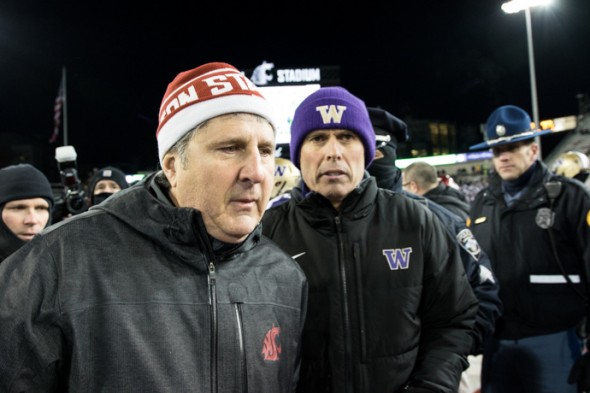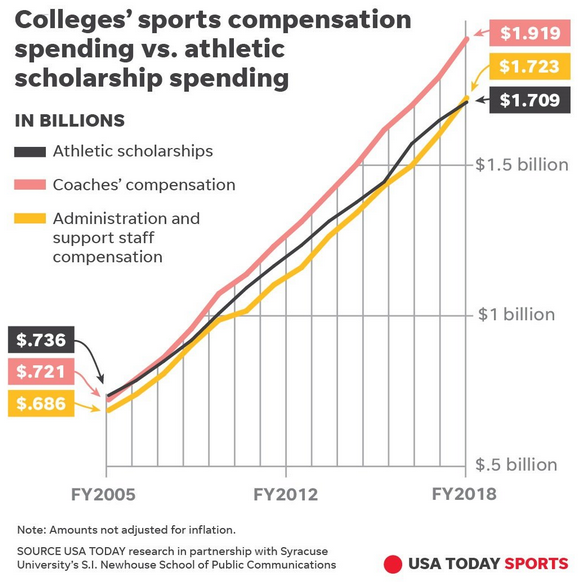
Fans have always known that team sports have hierarchies, the haves vs. the have-nots, royals vs. serfs, titans vs. runts, Monstars vs. Michael Jordan and Bugs Bunny, MLB vs. Mariners. In a way, it’s part of the industry’s charm, because everyone remembers where they were and what they felt when Cougars beat the Huskies in 1997 and went to the Rose Bowl for the first time since the continents rose from the seas and cooled.
Pro sports deserve a little credit for reducing the gap by installing economic restrictions such as salary caps with maximums and minimums and some limitations on player movement. MLB’s system is weak, the NBA’s is middling and the NFL’s the best by far, and the single biggest reason for its immense popularity: Every season begins with 20 to 25 fan bases believing that if things go well, they have a shot, and rest think they are one or two players away.
But when it comes to the trite phase of “even playing fields,” big-time college sports are wretched.
Yes, we all know that these activities are merely amateur student-athletes frolicking upon the campus greenswards between classes to keep their bodies honed as keenly as their minds.
Then we see that the University of Texas athletic department had operating revenues of $219.4 million in fiscal year 2017-18, and the mythology takes another knee to the nethers.
The nation-leading figure comes from USA Today’s splendid database that reports annually on the operating revenues and expenses of more than 230 public Division I college athletic departments. The complete list, released Monday, is here.
Yet the volume of money Texas, which has topped the rankings for several years, takes in is nowhere near the volume of gall the NCAA works up to call itself the steward of amateur sports.
But if we hustle past the foul odor of hypocrisy, the trip down the list quickly reveals the stench of disparity.
Nestled in at No. 53, between non-Power 5 schools UConn and Central Florida, is the 10th and final Pac-12 Conference school, Washington State (the two Pac-12 private schools, USC and Stanford, do not provide data).
The Cougars reported operating revenues of $65.1 million, more than three times less than the Longhorns’ colossus, and half the amount of the Pac-12 co-leaders, UCLA (21) and Washington (22) at $130.9 million.
None of this is a particular surprise to anyone who follows the business of college sports, although double-digit winning football seasons by WSU coach Mike Leach make him my heavy favorite to replicate the five-loaves-and-two-fish trick at the next New Testament party.
The disparity does point out why it’s so hard to make financial rules fair to all NCAA members, even within Division I. And since the list includes operational expenses, it discloses how hard it is for athletics budgets to break even, despite TV coverage among all schools of every competition above shopping-cart racing.
Three Pac-12 schools were in the black operationally:
- Washington: $131M in revenues/$126M in expenses
- Oregon: $122M/$120M
- Utah: $91M/$87M
Two broke even:
- UCLA: $131M/$131M
- Colorado: $90M/$90M
Five schools had deficits:
- Arizona State: $113M/$126M
- Arizona: $96M/$103M
- California: $91M/$110M
- Oregon State: $81/$89M
- Washington State $65M/$73M
The proximate cause for the Pac-12 financial struggles is, of course, the failure of the innovative Pac-12 Networks plan, which Commissioner Larry Scott promised would deliver revenues sufficient to cover the costs of the facilities arms race in which all conference schools indulged.
But that is a dead horse to be beaten on another day.
What the USA Today study also disclosed was that for the first time since this data became widely public 16 years ago, the expenses related to administrators and staffers, as well as head coaches, exceeded the costs for scholarship players.
A watershed moment.
Here’s a graphic that captures the growth increases:
 Here’s how I interpret the data: Whenever NCAA President Mark Emmert, or college presidents, or athletics directors bleat that there is not enough money to pay scholarship athletes a living wage, they are gaslighting us. The bloating at the executive/admin level is taking an increasing share.
Here’s how I interpret the data: Whenever NCAA President Mark Emmert, or college presidents, or athletics directors bleat that there is not enough money to pay scholarship athletes a living wage, they are gaslighting us. The bloating at the executive/admin level is taking an increasing share.
Ever since TV revenues skyrocketed for college football in the 1980s, there has always been enough money to pay players beyond the value of their scholarships for the full-time gigs they do for their schools beyond studenting. It’s all in how the pie is sliced.
But it isn’t just the football/basketball coaches and admins who are fat-catting it. USA Today also reported there is now a big spike in salaries for head coaches of the non-revenue sports.
In 23 sports besides football, salary, benefits and bonuses for head coaches grew 43 percent from 2013 to 2018. In the same period, salaries for football coaches increased by 51 percent.
U.S. Sen. Chris Murphy (D-Conn.) told USA Today: “You’ve got this relatively small handful of money-making sports programs that can credibly justify paying enormous coach salaries based upon the money they make, but that clearly puts a pressure on the schools in the (sports) programs that aren’t making money to pay similar salaries.
“To me, it’s fascinating that none of these schools feel any pressure to do better by the kids — that (some) coaches are making 60 percent more than they were five years ago, and the students haven’t gotten a dime in compensation during that time.”
The blatant inequity is largely why the California state legislature is getting ready to pass on Aug. 30 a law, the first of its kind in the nation, to force the NCAA to compensate players beyond scholarships. Since the start date isn’t until 2023, there’s enough time for the NCAA to try, and likely fail, to litigate against it successfully.
Then Emmert and his bosses will be forced to come up with a plan that will have to include haircuts for everyone making more than, say, $40,000 a year.
It will be hard. But not as hard as pleading poverty when athletics department budgets generate more than $200 million annually, and payments to bosses cost more than scholarships.
Trendy as it is, not every school simultaneously can be a have-not.

11 Comments
More progress for college athletes? We will see. In the day, PAC 8, you got room and board, tuition, tutors, meal money on the road, and you could sell your tickets. I gave my tickets to teamates and visiting family or friends. There were many teamates who couldn’t rub two nickles together on any given day.
The last sentence is still true today, although many more kids and their parents are being bribed pre-enrollment with laundered money.
Hell, other conferences gave laundry money for laundry not the PAC 8.
Pac 8 was as dirty as any league. Ask Hugh McElhenny.
The tsunami of money coming into D-1 programs (mostly from media) has resulted in facilities and coaches arms races. The schools have new palaces, including athletic administration buildings and players’ lounges fit for a Trump. A million dollar annual salary for an ASSISTANT coach is now commonplace. A generation ago, players had spring practice, summer practice, the regular season and a bowl game. Now, players work out in un-organized, organized and “on-the-side” (wink-wink) activities 12 months a year. Summer jobs were once the norm, but now a rarity. It is not unusual to do “mat work” and strength training at 6am. A thousand dollars a month to the players– many of whom don’t have money for pizza or a movie– would be like drops in the ocean. Meanwhile, jerseys with Myles Gaskin’s name and number were sold and Myles received not a friggin’ dime. Wrong…just wrong.
I was afraid you might need convincing about the corruption. But no.
You had me at hello.
I wonder if WSU would have better numbers if they made an effort to retain Bill Moos?
Good article but I’ve yet to see anyone address the 800 pound gorilla in the room which is title IX. Once you compensate the male football/basketball players an equal amount is going to have to be paid to female athletes. Given that the vast majority of programs already operate in the red I just don’t see how there would be enough money to go around even with a haircut
Thanks Art! The saga of compensation for college athletes continues….
It’s great to see someone attempt to make some ground on compensation. It’s also amazing to see how the tete of excess funds, no mater how much, always seems to get used up by admins and non-revenue sport coaches. I’d say that those operating in a deficit either need better money managers, or their revenues haven’t taken in account accurately the cover charge for participation.
I’m all for supplementing the student athletes – they deserve it, and it’s a fair thing to do considering the profits others are making off of them. Though I think it should be structured to promote educational goals too, otherwise it’s hypocritical, and we should just call college “pro-lite” leagues.
If compensation does indeed happen, in the long run, if there isn’t some sort of regulation evening out what schools can spend, then there is no chance for fairness in competition across the divisions – we’d still be looking at the the Budweiser hydros of college football continuing to buy their teams and coaches. Can two birds be killed with one stone? Maybe not…..
Although I think it’s immoral that universities are reaping millions from their football and men’s basketball programs off the backs of athletes who receive no compensation for the revenue they generate (hello, Ed O’Bannon), paying those player could open a Pandora’s Box of sorts because what would stop athletes in other money-losing programs like golf, tennis or soccer from also demanding compensation? Or is everyone secure in the knowledge that no class action lawsuit from such athletes would ever be filed?
All that is partial reason why I’ve steadily lost interest in big-time college sports over the years. While I’ll always root for the Cougs (and, for 51 weeks per year, the Dawgs), I’ve developed a preference for D3 and NAIA sports because schools at that level don’t even offer scholarships and the players we see on Saturday will be in the classroom on Monday working toward their degrees. You know, like real student-athletes.